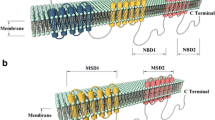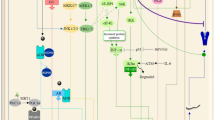Abstract
Nucleotide efflux (especially cyclic nucleotides) from a variety of mammalian tissues, bacteria, and lower eukaryotes has been studied for several decades. However, the molecular identity of these nucleotide efflux transporters remained elusive, despite extensive knowledge of their kinetic properties and inhibitor profiles. Identification of the subfamily of adenosine triphosphate (ATP) binding cassette transporters, multidrug resistance protein (MRP) subfamily, permitted rapid advances because some recently identified MRP family members transport modified nucleotide analogs (ie, chemotherapeutic agents). We first identified, MRP4, based on its ability to efflux antiretroviral compounds, such as azidothymidine monophosphate (AZT-MP) and 9-(2-phosphonyl methoxyethyl) adenine (PMEA), in drug-resistant and also in transfected cell lines. MRP5, a close structural homologue of MRP4 also transported PMEA. MRP4 and MRP5 confer resistance to cytotoxic thiopurine nucleotides, and we demonstrate MRP4 expression varies among acute lymphoblastic leukemias, suggesting this as a factor in response to chemotherapy with these agents. The ability of MRP4 and MRP5 to transport 3,5-cyclic adenosine monophosphate (cAMP) and 3,5-cyclic guanosine monophosphate (cGMP) suggests they may play a biological role in cellular signaling by these nucleotides. Finally, we propose that MRP4 may also play a role in hepatic bile acid homeostasis because loss of the main bile acid efflux transporter, sister of P-glycoprotein (SPGP) aka bile-salt export pump (BSEP), leads to a strong compensatory upregulation in MRP4 expression. Cumulatively, these studies reveal that the ATP-binding cassette (ABC) transporters MRP4 and MRP5 have a unique role in biology and in chemotherapeutic response.
Similar content being viewed by others
References
Plagemann PGW. Transport, phosphorylation, and toxicity of a tricyclic nucleoside in cultured Novikoff rat hepatoma cells and other cell lines and release of its monophosphate by the cells. J Natl Cancer Inst. 1976;57(6):1283–1295.
Plagemann PGW, Erbe J. Exit transport of a cyclic nucleotide from mouse L-cells. J Biol Chem. 1977;252(6):2010–2016.
Veal GJ, Back DJ. Metabolism of zidovudine. Gen Pharmacol. 1995;26(7):1469–1475.
Frick LW, Nelson DJ, St. Clair MH, Furman PA, and Krenitsky TA. Effects of 3-azidothymidine on the deoxynucleotide triphosphate pools of cultured human cells. Biochem Biophys Res Comm. 1988;154:124–129.
Fridland A, Connelly MC, Ashmun R. Relationship of deoxynucleotide changes to inhibition of DNA synthesis induced by the antiretroviral agent 3-azido 3-deoxythymidine and release of its monophosphate by human lymphoid cells (CCRF-CEM). Mol Pharmacol. 1990;37(5):665–670.
Hall ET, Yan JP, Melancon P, Kuchta RD. 3-Azido-3-deoxythymidine potently inhibits protein glycosylation: a novel mechanism for AZT cytotoxicity. J Biol Chem. 1994;269(20):14355–14358.
Tornevik Y, Ullman B, Balzarini J, Wahren B, Eriksson S. Cytotoxicity of 3-azido-3-deoxythymidine correlates with 3-azidothymidine-5-monophosphate (AZTMP) levels, whereas anti-human immunodeficiency virus (HIV) activity correlates with 3-azidothymidine-5-triphosphate (AZTTP) levels in cultured CEM T-lymphoblastoid cells. Biochem Pharmacol. 1995; 49(6):829–837.
Hatse S, de Clercq E, Balzarini J. Impact of 9-(2-phosphonylmethoxyethyl) adenine on (deoxy) ribonucleotide metabolism and nucleic acid synthesis in tumor cells. FEBS Lett. 1999;445:92–97.
Robbins BL, Connelly MC, Marshall DR, Srinivas RV, Fridland A. A human T lymphoid cell variant resistant to the acyclic nucleoside phosphonate 9-(2-phosphonylmethoxyethyl) adenine shows a unique combination of a phosphorylation defect and increased efflux of the agent. Mol Pharmacol. 1995;47:391–397.
Hatse S, de Clercq E, Balzarini J. Enhanced 9-(2-phosphonylmethoxyethyl) adenine secretion by a specific, indomethacin-sensitive efflux pump in a mutant 9-(2-phosphonylmethoxyethyl) adenine-resistant human erythroleukemia K562 cell line. Mol Pharmacol. 1998;54:907–917.
Butcher RW, Robison GA, Hardman JG, Sutherland EW. The role of cyclic AMP in hormone actions. Adv Enzyme Regul. 1968;6:357–389.
Newell PC. Signal transduction and motility of Dictyostelium. Biosci Rep. 1995;15(6):445–462.
Morrill GA, Doi K, Erlichman J, Kostellow AB. Cyclic AMP binding to the amphibian oocyte plasma membrane: possible interrelationship between meiotic arrest and membrane fluidity. Biochim Biophys Acta. 1993;1158:146–154.
Maller JL, Butcher FR, Krebs EG. Early effect of progesterone on levels of cyclic Adenosine 3, 5-monophosphate in Xenopus oocytes. J Biol Chem. 1979;254(3):579–582.
Schorderet-Slatkine S, Schorderet M, Baulieu EE. Cyclic AMP-mediated control of meiosis: effects of progesterone, cholera toxin, and membrane-active drugs in Xenopus laevis oocytes. Proc Natl Acad Sci U S A. 1982;79:850–854.
Abell CW, Monahan TM. The role of adenosine 3, 5-cyclic monophosphate in the regulation of mammalian cell division. J Cell Biol. 1973;59(3):549–558.
Pastan IH, Johnson GS, Anderson WB. Role of cyclic nucleotides in growth control. Ann Rev Biochem. 1975;44:491–522.
Wang T, Sheppard JR, Foker JE. Rise and fall of cyclic AMP required for onset of lymphocyte DNA synthesis. Science. 1978;201:155–157.
Kaminsky NI, Broadus AE, Hardman JG, et al. Effects of parathyroid hormone on plasma and urinary adenosine 3, 5-monosphosphate in man. J Clin Invest. 1970;49(12):2387–2395.
Kuster J, Zapf J, Jakob A. Effects of hormones on cyclic AMP release in perfused rat livers. FEBS Lett. 1973;32(1):73–77.
Zumstein P, Zapf J, Froesch ER. Effects of hormones on cyclic AMP release from rat adipose tissue in vitro. FEBS Lett. 1974;49(1):65–69.
O Brien JA, Strange RC. The release of adenosine 3, 5-cyclic monophosphate from the isolated perfused rat heart. Biochem J. 1975;152(2):429–432.
Cramer H, Lindl T. Release of cyclic AMP from rat superior cervical ganglia after stimulation of synthesis in vitro. Nature. 1974;249(455):380–382.
Brunton LL, Buss JE. Export of cyclic AMP by mammalian reticulocytes. J Cyclic Nucl Res. 1980;6(5):369–377.
Barber R, Ray KP, Butcher RW. Turnover of adenosine 3, 5-monophosphate in WI-38 cultured fibroblasts. Biochemistry. 1980;19(12):2560–2567.
Barber R, Butcher RW. The quantitative relationship between intracellular concentration and egress of cyclic AMP from cultured cells. Mol Pharmacol. 1981;19(1):38–43.
Fehr TF, Dickinson ES, Goldman SJ, Slakey LL. Cyclic AMP efflux is regulated by occupancy of the adenosine receptor in pig aortic smooth muscle cells. J Biol Chem. 1990;265(19):10974–10980.
Ahlstrom M, Lamberg-Allardt C. Regulation of adenosine 3, 5-cyclic monophosphate (cAMP) accumulation in UMR-106 osteoblast like cells: role of cAMP-phosphodiesterase and cAMP efflux. Biochem Pharmacol. 1999;58:1335–1340.
Brunton LL, Mayer SE. Extrusion of cyclic AMP from pigeon erythrocytes. J Biol Chem. 1979;254(19):9714–9720.
Boxer LA, Allen JM, Baehner RL. Diminished polymorphonuclear leukocyte adherence: function dependent on release of cyclic AMP by endothelial cells after stimulation of beta-receptors by epinephrine. J Clin Invest. 1980;66(2):268–274.
Henderson GB, Strauss BP. Evidence for cAMP and cholate extrusion in C6 rat glioma cells by a common anion efflux pump. J Biol Chem. 1991;266(3):1641–1645.
Kapoor CL, Krishna G. Hormone-induced cyclic guanosine monophosphate secretion from guinea pig pancreatic lobules. Science. 1977;196(4293):1003–1005.
Tjornhammar ML, Lazaridis G, Bartfai T. Cyclic GMP efflux from liver slices. J Biol Chem. 1983; 258(11):6882–6886.
Tjornhammar ML, Lazaridis G, Bartfai T. Efflux of cyclic guanosine 3, 5-monophosphate from cerebellar slices stimulated by L glutamate or high K+ or N-methyl-N-nitro-N-nitrosoguanidine. Neurosci Lett. 1986;68(1):95–99.
Hamet P, Pang SC, Tremblay J. Atrial natriuretic factor-induced egression of cyclic guanosine 3, 5-monophosphate in cultured vascular smooth muscle and endothelial cells. J Biol Chem. 1989; 264(21):12364–12369.
Flo K, Hansen M, Orbo A, Kjorstad KE, Maltau JM, Sager G. Effect of probenecid, verapamil and progesterone on the concentration-dependent and temperature-sensitive human erythrocyte uptake and export of guanosine 3, 5 cyclic monophosphate (cGMP). Scand J Clin Lab Invest. 1995;55(8):715–721.
Schultz C, Vaskinn S, Kildalsen H, Sager G. Cyclic AMP stimulates cyclic GMP egression pump in human erythrocytes: effects of probenecid, verapamil, progesterone, theophylline, IBMX, forskolin, and cyclic AMP on cyclic GMP uptake and association to inside-out vesicles. Biochemistry. 1998;37(4):1161–1166.
Boadu E, Sager G. Binding characterization of a putative cGMP transporter in the cell membrane of human erythrocytes. Biochemistry. 1997;36:10954–10958.
Patel MJ, Wypij DM, Rose DA, Rimele TJ, Wiseman JS. Secretion of cyclic GMP by cultured epithelial and fibroblast cell lines in response to nitric oxide. J Pharm Exp Therap. 1995;273:16–25.
Billiar TR, Curran RD, Harbrecht BG, et al. Association between synthesis and release of cGMP and nitric oxide biosynthesis by hepatocytes. Am J Physiol. 1992;262:C1077:82.
Doore J, Bashor MM, Spitzer N, Mawe EC, Saier MH. Regulation of adenosine 3∶5-monophosphate efflux from glioma cells in culture. J Biol Chem. 1975;250:4371–4371.
Rindler MJ, Bashor MM, Spitzer N, Saier MH. Regulation of adenosine 3∶5-monophosphate efflux from animal cells. J Biol Chem. 1978;253:5431–5436.
Finnegan RB, Carey GB. Characterization of cyclic AMP efflux from swine adipocytes in vitro. Obesity Res. 1998;6(4):292–298.
Campbell IL, Taylor KW. The effect of metabolites, papaverine, and probenecid on cyclic AMP efflux from isolated rat Islets of Langerhans. Biochim Biophys Acta. 1981;676(3):357–364.
Henderson GB, Tsuji JM. Methotrexate efflux in L1210 cells: kinetic and specificity properties of the efflux system sensitive to bromosulfophthalein and its possible identity with a system which mediates the efflux of 3, 5-cyclic AMP. J Biol Chem. 1987;262(28):13571–13578.
Gogel E, Halloran BP, Strewler GJ. Probenecid inhibits the secretion of nephrogenous adenosine 3, 5-monophosphate in normal man. J Clin Endocrinol Metab. 1983;57:689–693.
Heasley LE, Brunton LL. Prostaglandin A1 metabolism and inhibition of cyclic AMP extrusion by avian erythrocytes. J Biol Chem. 1985;260(21):11514–11519.
Heasley LE, Watson MJ, Brunton LL. Putative inhibitor of cyclic AMP efflux: chromatography, amino acid composition, and identification as a prostaglandin A1-glutathione adduct. J Biol Chem. 1985;260(21):11520–11523.
Heasley LE, Azari J, Brunton LL. Export of cyclic AMP from avian red cells: independence from major membrane transporters and specific inhibition by prostaglandin A1. Mol Pharmacol. 1985;27(1):60–65.
Coulson R, Baranaik J, Stec WJ, Jastriff B. Transport and metabolism of N6- and C8-substituted analogs of adenosine 3, 5-monophosphate and adenosine 3, 5-cyclicphophorothioate by the isolated perfused rat kidney. Life Sci. 1983;32:1489–1498.
Kool M, de Haas M, Scheffer GL, et al. Analysis of expression of cMOAT (MRP2), MRP3, MRP4, and MRP5, homologues of the multidrug resistance-associated protein gene (MRP1), in human cancer cell lines. Cancer Res. 1997;57:3537–3547.
Moser M. 51 Human ATP-Binding Cassette Transporters. Available at: http://humanabc.4t.com/humanabc.htm. Accessed: April 11, 2002
Borst P, Evers R, Kool M, Wijnholds J. The multidrug resistance protein family. Biochem Biophys Acta. 1999;1461(2):347–357.
Borst P, Evers R, Kool M, Wijnholds J. A family of drug transporters: the Multidrug Resistance-associated Proteins. J Natl Cancer Inst. 2000;92(16):1295–1302.
Schuetz JD, Connelly MC, Sun D, et al. MRP4: A previously unidentified factor in resistance to nucleoside-based antiviral drugs. Nat Med. 1999;5(9):1048–1051.
Lee K, Klein-Szanto AJP, Kruh GD. Analysis of the MRP4 drug resistant profile in transfected NIH3T3. J Natl Cancer Inst. 2000;92(23):1934–1940.
Chen ZS, Lee K, Kruh GD. Transport of cyclic nucleotides and estradial 17-beta-D-glucoronide by multidrug resistance protein 4: resistance to 6-mercaptopurine and 6-thioguanine. J Biol Chem. 2001;276(36):33747–33754.
Wijnholds J, Mol CA, van Deemter L, et al. Multidrug-resistance protein 5 is a multispecific organic anion transporter able to transport nucleotide analogs. Proc Natl Acad Sci U S A. 2000;97(13):7476–7481.
Jedlitschky G, Burchell B, Keppler D. The multidrug resistance protein 5 functions as an ATP-dependent export pump for cyclic nucleotides. J Biol Chem. 2000;275(39):30069–30074.
Shoshani I, Laux WH, Perigaud C, Gosselin G, Johnson RA. Inhibition of adenylyl cyclase by acyclic nucleoside phosphonate antiviral agents. J Biol Chem. 1999;274:34742–34744.
Schuetz EG, Strom S, Yasuda K, et al. Disrupted bile acid homeostasis reveals an unexpected interaction among nuclear hormone receptors, transporters and cytochrome P450. J Biol Chem. 2001;276(42):39411–39418.
Sinal CJ, Tohkin M, Miyata M, Ward JM, Lambert G, Gonzalez FJ. Targeted disruption of the nuclear receptor FXR/BAR impairs bile acid and lipid homeostasis. Cell. 2000;102:731–744.
Author information
Authors and Affiliations
Corresponding author
Additional information
Published: September 11, 2002
Rights and permissions
About this article
Cite this article
Sampath, J., Adachi, M., Hatse, S. et al. Role of MRP4 and MRP5 in biology and chemotherapy. AAPS J 4, 14 (2002). https://doi.org/10.1208/ps040314
Received:
Accepted:
Published:
DOI: https://doi.org/10.1208/ps040314




